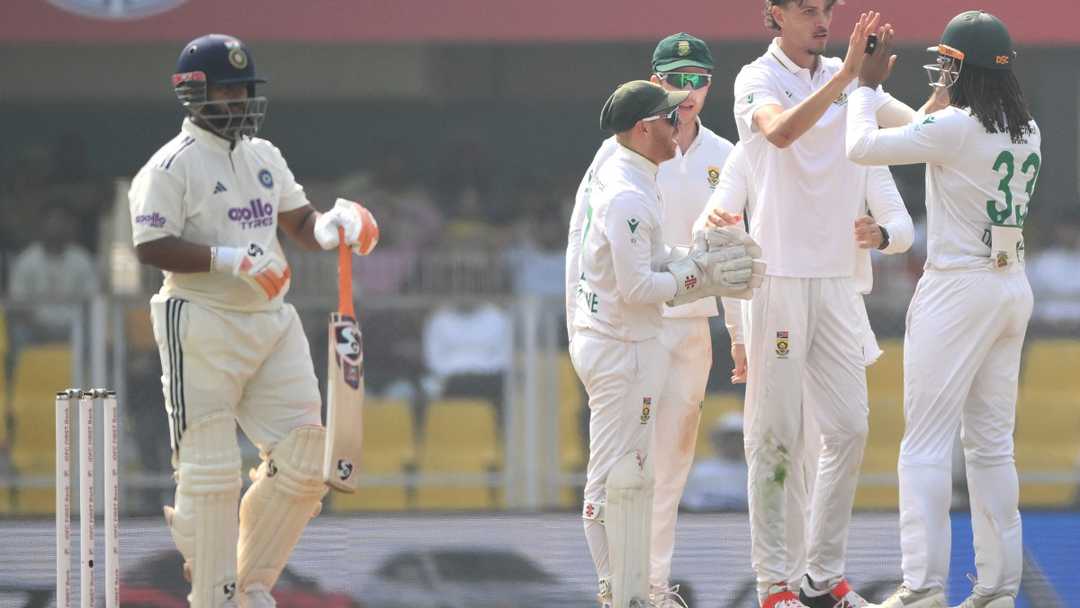
Demons in the mind
To understand how far India fell on Day 3 in Guwahati, consider the 82nd over of their innings in the final session. Kuldeep Yadav pushed a Marco Jansen delivery to deep backward point and turned down a single, keeping Jasprit Bumrah at the non-striker's end.
There was a touch of tragicomedy to it—India's No. 9 farming strike from the No. 10 on what should've been the team's big batting day. Two balls later he nicked off and walked back. He'd batted out 134 deliveries for 19 runs—22.2 overs for 19 runs. This is no slight on Kuldeep, but an indictment of India's messy approach through the middle that has left them in an almost-unwinnable position.
Test cricket has always been framed as a game of attrition. But time has offered a chance at evolution, and different routes have been mapped out. Myths have been debunked and new bold methods embraced. Just two days ago in Perth, Travis Head felt the need to play aggressively. England have been doing it for more than a year now, despite middling results.
It's a school of thought that perhaps resonates with Rishabh Pant too. But a batting ideology bereft of context can sometimes be rendered meaningless. In the second over after Tea, Marco Jansen fired a bumper at the Indian captain, who comfortably ducked under it. Temba Bavuma then moved Tony de Zorzi from slip to under the lid at forward short leg—a clear message to Pant that more short-pitched bowling was coming.
Before we get to what happened next, here's the context: For 17 minutes leading up to Tea, India relinquished all the good progress Yashasvi Jaiswal made with his 97-ball 58. It started with his exit, when a Simon Harmer ball stopped and bounced more than expected, forcing a checked drive that flew to Jansen at short third.
Not for the first time in this series, a hit-me ball from Harmer brought a wicket. In Kolkata, it was Dhurv Jurel; in Guwahati, Sai Sudharsan pulled one to Ryan Rickelton at mid-wicket.
Jurel's idea wasn't wrong at Eden Gardens when he tried to smash a long-hop from Harmer, but what he did in Guwahati—a tame, miscued pull against a Jansen short ball well outside off—was the opposite. Just like that, India lost three wickets for seven runs in 20 deliveries heading into the break.
Which brings us to Pant's response. For long, the wicketkeeper-batter has sworn by 'hitting back at the opposition' and succeeded worldwide. He's one of India's biggest match-winners batting this way. But the gamestate should have weighed heavily on him, burdened with captaincy, when he faced another Jansen bouncer. He still chose to step out and swing across the line, edging behind.
It's no secret that Pant's game is full of low-percentage shots, and often he isn't blamed for trying them. But this was not one of those days. A little restraint, however uncharacteristic, could've given him a chance against lesser bowlers in South Africa's attack. Even if Simon Harmer bowled a long spell, Bavuma would've been forced to give his main pacer a break soon. Jansen bowled three overs before Tea and might have gone on for three or four more in search of a breakthrough. But Pant gave Bavuma a reason to push his pacer, and the cascading effect was two more wickets—both off short balls.
Nitish Reddy couldn't keep away from one fired at his body and gloved it, while Ravindra Jadeja expected one to rise higher and turned away, only for it to hit his shoulder and ricochet off his bat. You could offer Jadeja some leeway for ill-luck, but Nitish's awkward fending raises a bigger question about India's squad planning: Is there a real need for a severely under-bowled seam-bowling all-rounder in Indian conditions, where a specialist batter could fit better?
At the end of the day, Jansen revealed that repeatedly going short wasn't a specific plan he started with. It worked itself into his bowling in conditions where the ball wasn't nipping around like in Kolkata. Jansen bowled 19.5 overs in the innings—10.2 of those were short-pitched deliveries, where he eked out a false shot percentage of 26.2 and picked all six of his wickets for just 19 runs.
As Washington Sundar—in at No. 8—and Kuldeep batted time, it became clear there were no demons on this pitch, and the softer ball didn't turn sharply or at pace either. "Honestly, it is a true wicket. If you spend time there, runs are for the taking," Washington said after a sobering day for the home side. There was light at the end of the tunnel for the batters here. India just didn't show the patience to find their way across and see it.


